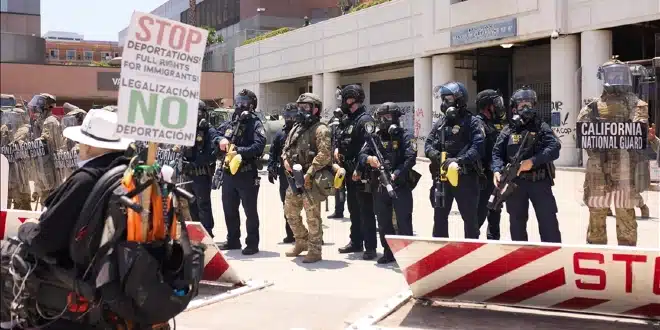Authorities in Los Angeles declared a state of unlawful assembly late Sunday following widespread unrest sparked by immigration enforcement actions and the deployment of National Guard troops ordered by former President Donald Trump. Protesters clashed with law enforcement, prompting the use of tear gas and other crowd-control tactics in various parts of the downtown area.
Unrest began after a wave of immigration raids led to dozens of arrests across the city, with federal authorities describing the detainees as undocumented migrants and gang affiliates. The enforcement operations, coupled with Trump’s decision to deploy military personnel to California without state approval, provoked demonstrations that quickly escalated in size and intensity.
California Governor Gavin Newsom condemned the federal intervention, calling it a violation of the state’s autonomy. He urged protesters to remain peaceful while warning that those engaging in violence would face legal consequences. In public statements, Newsom accused Trump of seeking to escalate tensions and politicize the situation. Legal action from the state of California is reportedly being considered.
Escalation in the Streets and a Federal Response
By Sunday afternoon, protests had intensified in downtown Los Angeles, where self-driving Waymo vehicles were set on fire and confrontations between demonstrators and law enforcement led to injuries and arrests. Police formed containment lines around key federal sites to prevent direct clashes between protestors and the National Guard troops deployed from the 79th Infantry Brigade Combat Team. These troops were observed in full tactical gear near high-risk areas.
The Los Angeles Police Department reported at least 56 arrests over two days of protests, along with minor injuries sustained by three officers. In a related development, San Francisco authorities also confirmed around 60 arrests following similar demonstrations in Northern California.
During a live television broadcast, an Australian journalist was struck in the leg by a rubber bullet, though she was not seriously injured. Media footage from aerial drones and local broadcasters showed small groups of protestors throwing objects and fireworks at law enforcement late into Sunday night.
Former President Trump, commenting on the situation via his social media platform, referred to the demonstrators as insurrectionists and called for the immediate arrest of masked participants. He reaffirmed his support for a militarized response and did not rule out invoking the Insurrection Act to authorize broader federal troop deployments across the United States.
The U.S. Northern Command confirmed that approximately 500 Marines had been placed on standby to support the National Guard if required. These preparations come amid mounting concerns over the potential for further unrest in other major cities.
Federal-State Power Struggle Over Military Deployment
The deployment marks a significant legal and political flashpoint. While National Guard units are routinely mobilized during natural disasters or to address civil disorder, such actions traditionally occur with the cooperation of state governments. Trump’s decision to override Governor Newsom’s authority is the first of its kind since the 1965 use of federal forces during the civil rights movement.
Democratic leaders have criticized the move as a dangerous overreach. Former Vice President Kamala Harris described the federal deployment as a deliberate provocation. Newsom reiterated that the use of state-controlled forces without consultation sets a dangerous precedent, accusing Trump of inflaming the crisis for political gain.
Conversely, Republican leaders expressed support for Trump’s actions. House Speaker Mike Johnson dismissed the backlash, asserting that the governor was failing to maintain order and protect public safety.
Public reactions on the ground have reflected broader national divides. Protesters expressed concern that the military presence was aimed more at silencing dissent than restoring order. Some characterized the deployment as an intimidation strategy designed to stifle constitutionally protected demonstrations against federal immigration policies.


